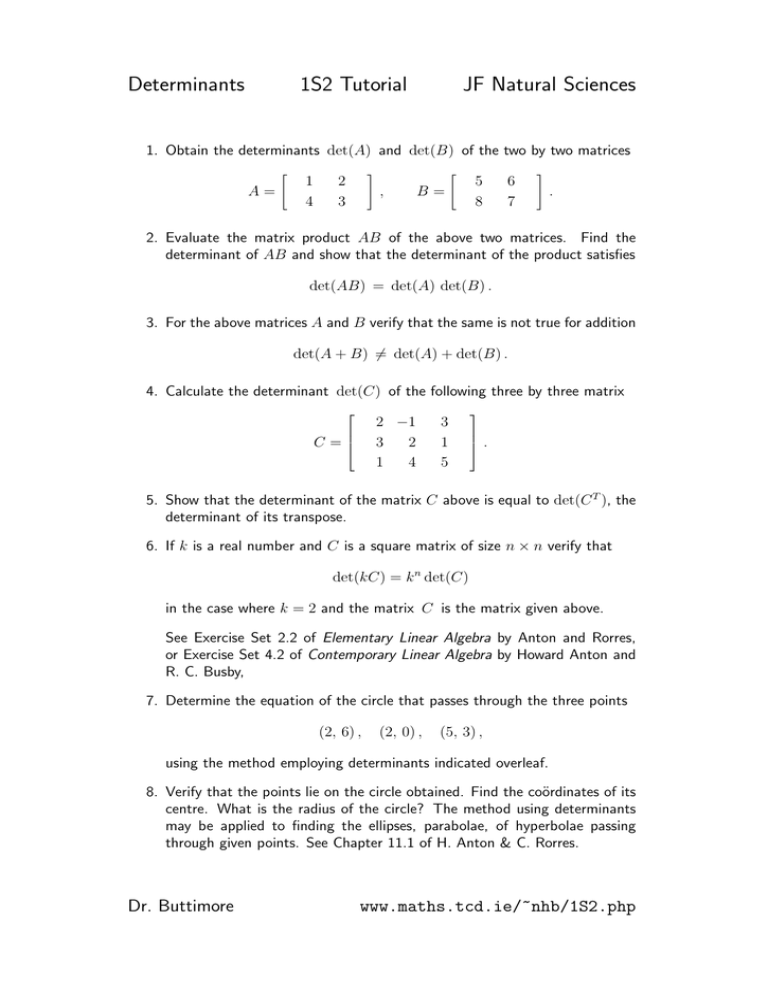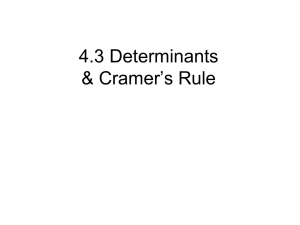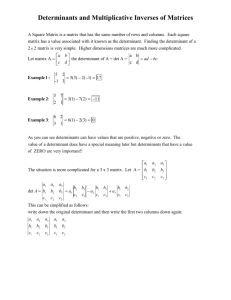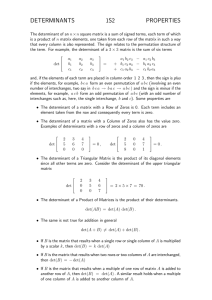Determinants 1S2 Tutorial JF Natural Sciences
advertisement

Determinants 1S2 Tutorial JF Natural Sciences 1. Obtain the determinants det(A) and det(B) of the two by two matrices A= " 1 4 # 2 3 , B= " 5 8 6 7 # . 2. Evaluate the matrix product AB of the above two matrices. Find the determinant of AB and show that the determinant of the product satisfies det(AB) = det(A) det(B) . 3. For the above matrices A and B verify that the same is not true for addition det(A + B) 6= det(A) + det(B) . 4. Calculate the determinant det(C) of the following three by three matrix 2 −1 3 2 1 4 C= 3 1 5 . 5. Show that the determinant of the matrix C above is equal to det(C T ), the determinant of its transpose. 6. If k is a real number and C is a square matrix of size n × n verify that det(kC) = k n det(C) in the case where k = 2 and the matrix C is the matrix given above. See Exercise Set 2.2 of Elementary Linear Algebra by Anton and Rorres, or Exercise Set 4.2 of Contemporary Linear Algebra by Howard Anton and R. C. Busby, 7. Determine the equation of the circle that passes through the three points (2, 6) , (2, 0) , (5, 3) , using the method employing determinants indicated overleaf. 8. Verify that the points lie on the circle obtained. Find the coördinates of its centre. What is the radius of the circle? The method using determinants may be applied to finding the ellipses, parabolae, of hyperbolae passing through given points. See Chapter 11.1 of H. Anton & C. Rorres. Dr. Buttimore www.maths.tcd.ie/~nhb/1S2.php CONSTRUCTING CURVES THROUGH SPECIFIED POINTS Q. What is the equation of the circle that passes through (1, 6), (8, 5) and (9, 2)? A general equation for the coordinates (x, y) of a point on a circle is of the form p (x2 + y 2 ) + qx + ry + s = 0 (1) where p, q, r, and s are coefficients that describe the location and size of the curve. If the circle passes through three distinct points, (1, 6), (8, 5) and (9, 2), then the following three equations must be satisfied by substitution (12 + 62 ) p + 1q + 6r + s = 0 (2) (82 + 52 ) p + 8q + 5r + s = 0 (3) (92 + 22 ) p + 9q + 2r + s = 0 . (4) Regarding the above four equations as a homogeneous system in the quantities p, q, r and s, the condition that there be a solution for p, q, r, and s not all zero is that the determinant of the corresponding matrix of the system be zero x2 + y 2 x y 1 37 1 6 1 89 8 5 1 85 9 2 1 = 0. Evaluating the determinant provides the required equation of the circle in the plane that passes through the three given points. Expansion by the top row yields 1 6 1 2 2 (x + y ) 8 5 1 9 2 1 37 6 1 − x 89 5 1 85 2 1 37 1 1 + y 89 8 1 85 9 1 37 1 6 − 89 8 5 85 9 2 = 0. Note the oscillating signs in the top row expansion of a typical n × n determinant 1 6 1 8 5 1 9 2 1 5 1 = 1 2 1 8 1 − 6 9 1 8 5 + 1 9 2 = 3 + 6 − 29 = −20 . See Chapter 11.1 of H. Anton & C. Rorres, Linear Algebra and Applications, 8e. Observe the following when evaluating the determinant of a square matrix A: 1. If B is the matrix that results when a single row or single column of A is multiplied by a scalar k, then det(B) = k det(A) 2. If B is the matrix that results when two rows or two columns of A are interchanged, then det(B) = − det(A) 3. If B is the matrix that results when a multiple of one row of matrix A is added to another row of A, then det(B) = det(A) . A similar result holds when a multiple of one column of A is added to another column of A.





